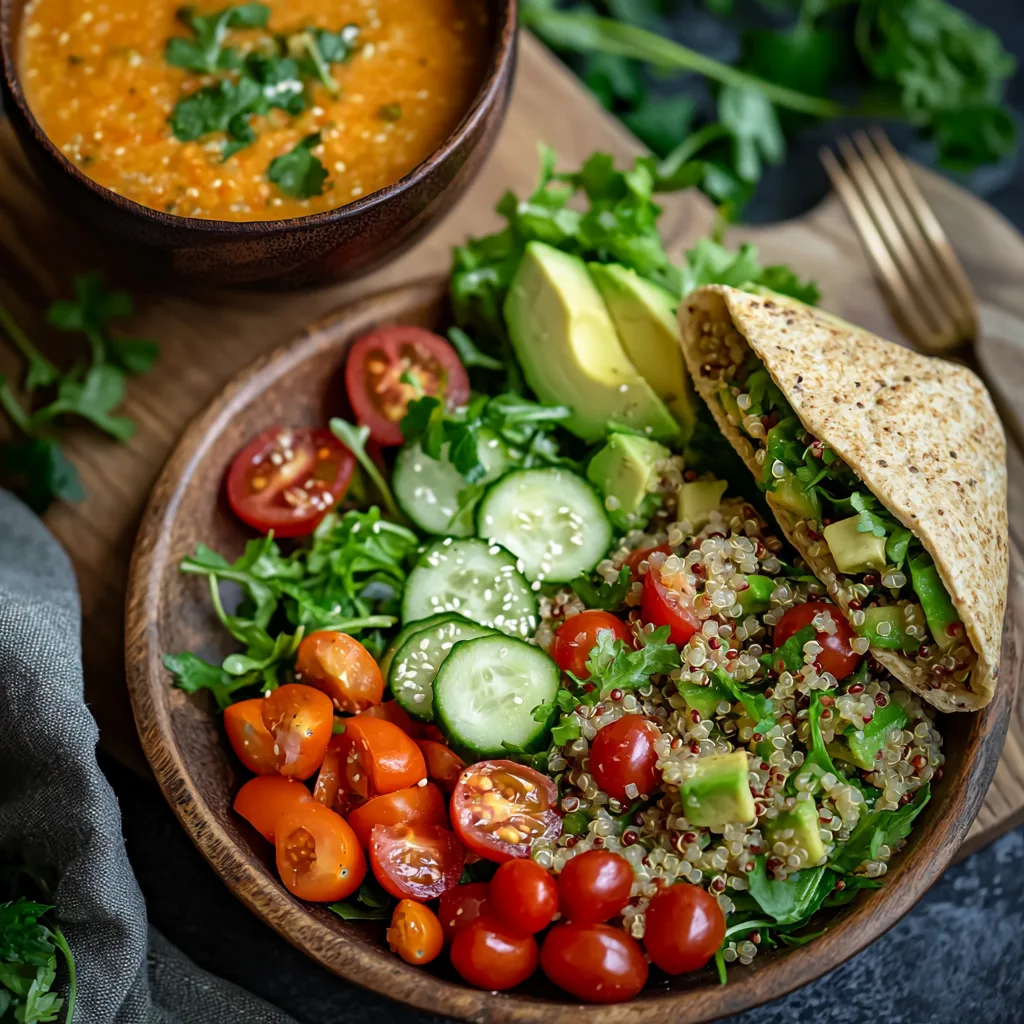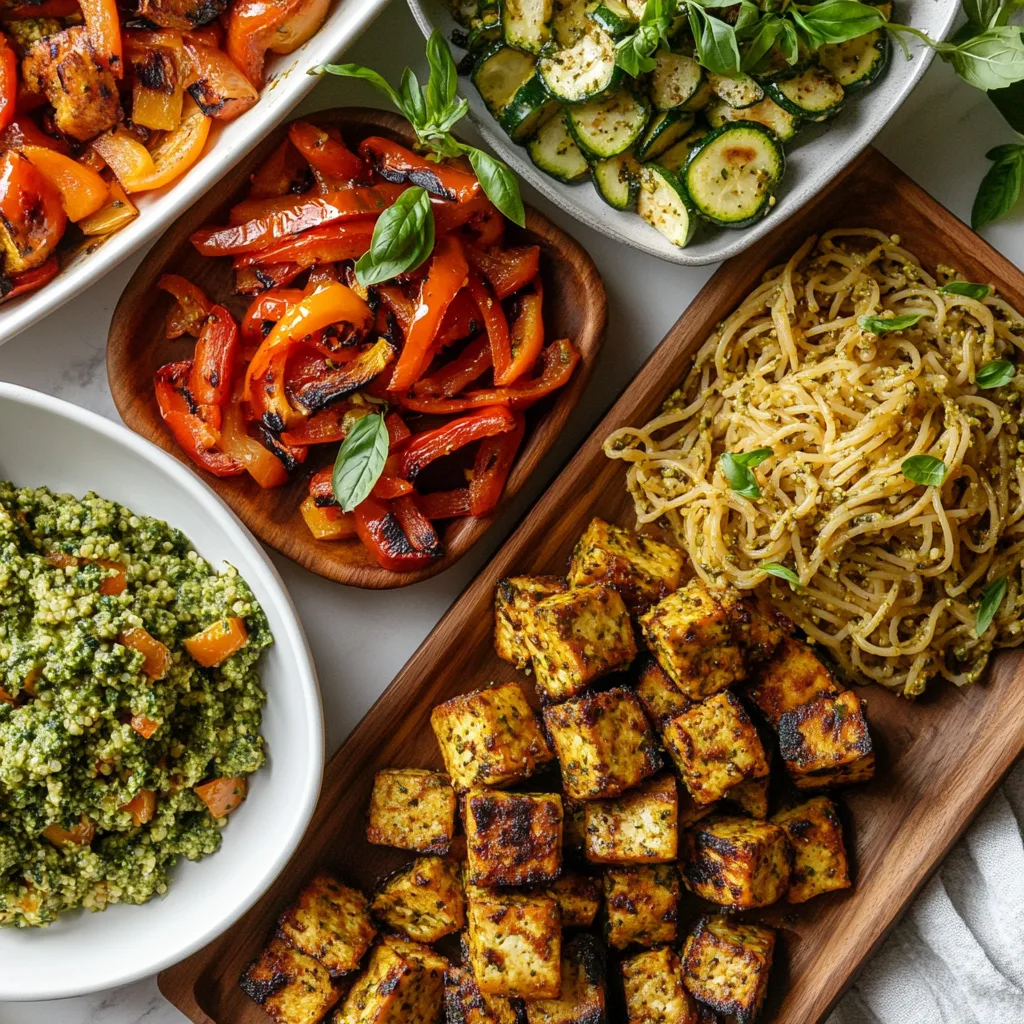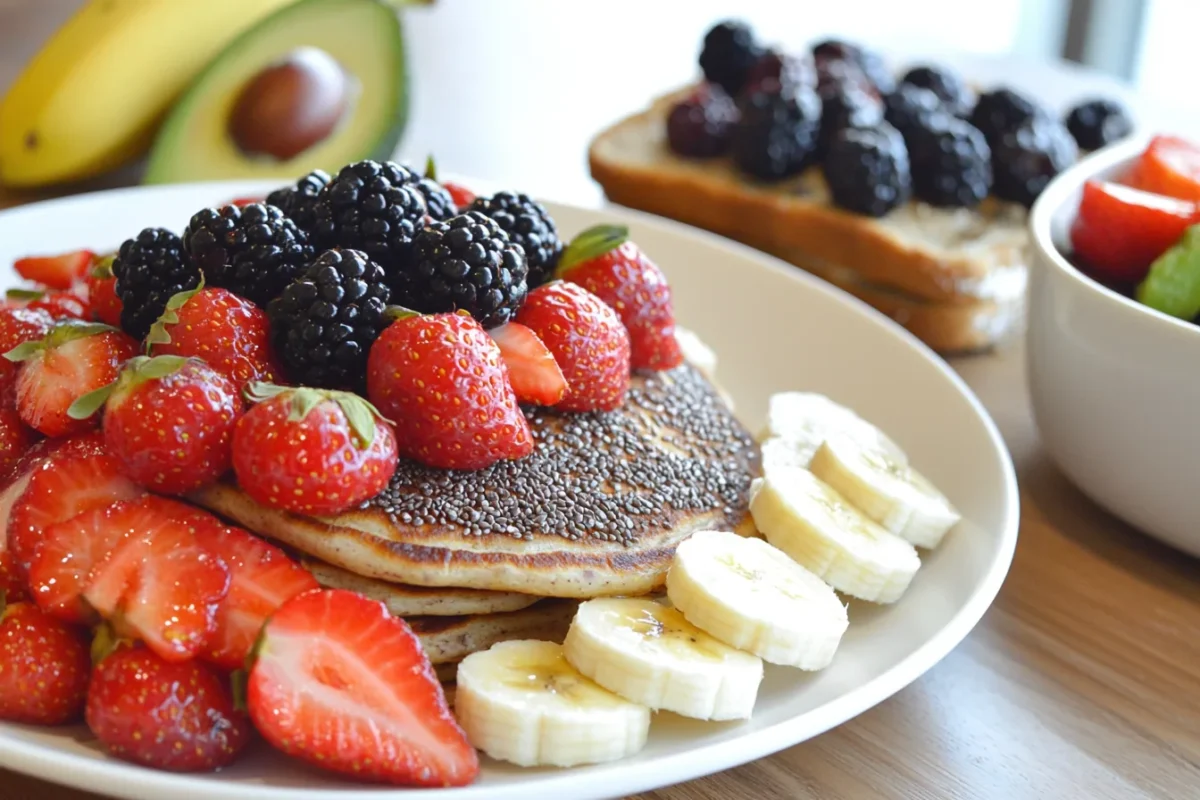Finding the right foods can feel challenging when you ask, “What do dairy-free and gluten-free people eat?” Many people face confusion while staring at their kitchen shelves, unsure of where to start. First, mornings shouldn’t begin with frustration about meals, and lunchtime shouldn’t feel like a puzzle.
Next, picture enjoying fluffy pancakes, vibrant smoothie bowls, or hearty quinoa salads—all free from gluten and dairy. These meals aren’t just tasty but also packed with nutrients. Also, they’re easy to prepare and perfect for busy days.
In addition, dairy-free and gluten-free diets offer endless possibilities. From sweet breakfast treats to savory dinner plates, there’s no shortage of delicious options. You’ll never feel restricted or bored with your meals.
So, if you’re ready to discover a variety of easy and satisfying meal ideas, keep reading. Let’s make every meal exciting, delicious, and worry-free! You’re going to love these ideas!
Table of Contents
Everyday Meal Ideas for Dairy-Free and Gluten-Free Diets
Quick and Easy Breakfast Choices
Starting your day with a delicious dairy-free and gluten-free breakfast is easier than you think. Smoothie bowls made with almond milk, fresh fruits, and chia seeds are quick and filling. Overnight oats prepared with gluten-free oats and plant-based milk are another fantastic option. Also, avocado toast on gluten-free bread with cherry tomatoes and seeds offers both nutrition and flavor.
In addition, scrambled eggs with vegetables like spinach and mushrooms create a protein-packed start to your day. For sweet options, gluten-free pancakes made with almond flour and topped with maple syrup are a treat. Energy bars made from nuts, seeds, and dates are perfect for busy mornings. These breakfast ideas are simple, nutritious, and satisfying.
For more creative and delicious gluten-free dairy-free breakfast ideas, explore a range of recipes and tips that will make your mornings stress-free and flavorful.
So, what do dairy-free and gluten-free people eat? They enjoy vibrant breakfasts packed with natural ingredients and incredible flavors. Try these options and start your day right!
Filling and Balanced Lunch Ideas

Lunch is an opportunity to refuel with a dairy-free and gluten-free meal packed with essential nutrients. First, grain bowls with quinoa, grilled vegetables, chickpeas, and leafy greens are filling and delicious. Next, fresh salads topped with avocado, seeds, nuts, and a light vinaigrette are refreshing choices.
In addition, gluten-free wraps filled with hummus, roasted veggies, leafy greens, and dairy-free cheese make for a quick and satisfying lunch. Soups made with fresh vegetables, dairy-free broth, and lentils are comforting and packed with flavor. Also, dairy-free cheese alternatives can be added to salads, wraps, or casseroles for an extra boost.
Whether you prefer something warm or cool, lunch can still be varied, colorful, and exciting. What do dairy-free and gluten-free people eat? Balanced meals made with wholesome ingredients and exciting flavors that keep you full and energized. Give these meal ideas a try and enjoy every flavorful bite!
Must-Have Staples for a Dairy-Free and Gluten-Free Pantry
Essential Ingredients for Daily Cooking
Building a dairy-free and gluten-free pantry starts with key ingredients that add versatility to meals. First, gluten-free grains like quinoa, rice, and certified gluten-free oats should be pantry staples. These grains are perfect for breakfast, lunch, or dinner recipes.
Next, plant-based milks such as almond, oat, or coconut milk are perfect for smoothies, baking, cereal, and coffee. Nut butters, like almond or peanut butter, add protein and natural flavor to any meal or snack. Also, coconut oil and olive oil are excellent dairy-free alternatives for cooking, sautéing, and baking.
In addition, stock up on fresh fruits, vegetables, and gluten-free pasta options for quick meal preparation. Nutritional yeast is a fantastic dairy-free substitute for cheesy flavors in sauces and dressings. These staples form the foundation for countless creative recipes. What do dairy-free and gluten-free people eat? They rely on these pantry essentials to create delicious, nutrient-dense, and satisfying meals every day.
Best Alternatives for Dairy and Gluten Products
Switching to dairy-free and gluten-free alternatives doesn’t mean sacrificing flavor or texture. First, almond milk, oat milk, and coconut milk are excellent replacements for dairy milk in baking, cooking, and beverages. Next, gluten-free flours like almond flour, rice flour, and coconut flour are perfect for making pancakes, muffins, and bread. These flours provide texture and flavor without using traditional wheat flour, making them ideal for both sweet and savory recipes.
In addition, dairy-free cheese options made from cashews or almonds add creaminess to sauces, pasta, and pizza. Coconut yogurt and soy yogurt are delicious swaps for dairy yogurt, offering smooth textures and tangy flavors. For spreads, nut butters and dairy-free cream cheese are reliable options. Gluten-free pasta made from rice or chickpeas is another pantry must-have. What do dairy-free and gluten-free people eat? With these delicious and versatile alternatives, they enjoy balanced meals without missing traditional ingredients.
Creative Dairy-Free and Gluten-Free Dinner Recipes
Flavorful One-Pan Meals

One-pan meals are perfect for busy evenings and require minimal cleanup. Start with gluten-free grains like rice or quinoa as a hearty base. Then, add colorful vegetables such as bell peppers, zucchini, and carrots for added texture and nutrition. These ingredients create a vibrant and balanced dish without much effort.
Next, toss in protein sources like tofu, grilled chicken, or beans to make the meal filling and satisfying. Season with fresh herbs, spices, and a drizzle of olive oil for maximum flavor. Dairy-free sauces made from coconut milk, tomato puree, or nutritional yeast can bring the dish together beautifully.
In addition, sheet pan dinners with roasted vegetables, seasoned tofu, or salmon provide a quick and fuss-free option. What do dairy-free and gluten-free people eat? They enjoy hearty, flavorful meals prepared with minimal effort, making dinnertime both delicious and stress-free. Try one-pan meals to simplify your evening routine!
Simple Comfort Food Options
Comfort food doesn’t have to include gluten or dairy to be delicious and satisfying. Start with hearty soups made with vegetable broth, fresh vegetables, and herbs. Then, add gluten-free pasta or rice for a warm and filling meal. These soups are perfect for chilly evenings or when you need something cozy.
Next, baked casseroles with dairy-free cheese alternatives and gluten-free breadcrumbs are rich and satisfying. Shepherd’s pie made with mashed potatoes, seasoned vegetables, and plant-based proteins is another comforting favorite. These dishes offer classic flavors without relying on gluten or dairy.
In addition, dairy-free sauces like pesto, tomato sauce, or creamy coconut milk-based sauces bring pasta dishes to life. What do dairy-free and gluten-free people eat? They enjoy comfort foods packed with familiar flavors and heartwarming textures. These recipes prove that dietary restrictions don’t mean sacrificing your favorite cozy meals.
Tips for Preparing Dairy-Free and Gluten-Free Meals
Smart Meal Prep Strategies
Meal prepping is a game-changer for maintaining a dairy-free and gluten-free lifestyle. Start by batch-cooking staple grains like rice, quinoa, or gluten-free pasta at the beginning of the week. Then, store them in airtight containers for easy access during meal prep. This step saves both time and effort on busy days.
Next, pre-chop vegetables such as bell peppers, carrots, and broccoli to have them ready for quick stir-fries, salads, or sheet pan meals. Also, prepare smoothie packs with frozen fruits, greens, and seeds, so they’re ready to blend each morning. These pre-prepared ingredients streamline meal creation and reduce kitchen stress.
In addition, sauces and dressings can be made in bulk and stored in jars for convenience. What do dairy-free and gluten-free people eat? Pre-planned, nutritious meals that are quick to assemble and packed with flavor. With smart meal prep strategies, eating well becomes easy and stress-free.
Time-Saving Cooking Hacks
Busy days call for clever cooking hacks to save time without compromising on flavor or nutrition. First, invest in helpful kitchen tools like slow cookers, pressure cookers, or rice cookers. These appliances can cook grains, soups, or stews with minimal supervision, freeing up your time for other tasks.
Next, focus on recipes with simple ingredients and short cooking times. Stir-fries, one-pan meals, and quick salads are great examples. Also, freeze individual portions of pre-cooked meals, such as casseroles, pancakes, or soups. Reheat them when needed for a quick and effortless meal solution.
In addition, dairy-free sauces, dips, and salad dressings can be prepared in advance and stored in jars. What do dairy-free and gluten-free people eat? They rely on smart cooking strategies to create tasty meals without spending hours in the kitchen. With these hacks, mealtime becomes efficient, enjoyable, and stress-free.
Health Benefits of a Dairy-Free and Gluten-Free Lifestyle
Improved Digestion and Gut Health
A dairy-free and gluten-free lifestyle can significantly improve digestion and support overall gut health. First, gluten-free grains like quinoa, brown rice, and certified gluten-free oats are rich in fiber, aiding smooth digestion. These grains are gentle on the stomach and help prevent bloating and discomfort.
Next, plant-based yogurts made from almond, coconut, or soy milk are excellent sources of probiotics. These friendly bacteria promote a healthy gut and support overall digestive health. In addition, fruits and vegetables like apples, berries, spinach, and kale are naturally rich in fiber and essential vitamins, which further improve digestion.
Also, seeds such as chia and flaxseeds add omega-3 fatty acids and soluble fiber, keeping your digestive system balanced. What do dairy-free and gluten-free people eat? Meals filled with natural, fiber-rich ingredients that support gut health and overall well-being. Every bite contributes to a healthier and happier digestive system.
Boosting Energy with the Right Foods
Energy levels can improve dramatically with the right dairy-free and gluten-free foods. First, gluten-free grains like oats, brown rice, and quinoa provide slow-releasing carbohydrates. These grains offer a steady source of energy, keeping you full and focused throughout the day.
Next, healthy fats from avocados, nuts, and seeds provide long-lasting fuel. Almond butter, peanut butter, and sunflower seed butter are great options for quick snacks. Also, smoothies made with almond milk, protein powder, and fresh fruits deliver an instant energy boost in a refreshing way.
In addition, dairy-free yogurts and nut-based energy bars are convenient on-the-go snacks that keep energy levels stable. Fresh fruits like bananas and apples add natural sweetness and quick energy. What do dairy-free and gluten-free people eat? Nutrient-rich meals and snacks that maintain energy, reduce fatigue, and improve focus. With these foods, you’ll feel fueled, focused, and ready to tackle the day ahead.
Common Mistakes to Avoid in Dairy-Free and Gluten-Free Eating
Preventing Cross-Contamination in the Kitchen
Cross-contamination is one of the biggest challenges when preparing dairy-free and gluten-free meals. Even small traces of gluten or dairy can cause discomfort or health issues for those with sensitivities. First, always use separate cutting boards, utensils, and cooking pans for gluten-free and dairy-free ingredients. This helps prevent accidental cross-contact.
Next, store gluten-free and dairy-free ingredients in clearly labeled, airtight containers to avoid confusion. Also, clean kitchen surfaces thoroughly before and after preparing meals. Even tiny crumbs from regular bread or a splash of dairy milk can lead to contamination.
In addition, invest in a separate toaster or use toaster bags specifically for gluten-free bread. Be cautious with condiments and spreads, as they can become contaminated if shared with regular bread or dairy-based products. What do dairy-free and gluten-free people eat? Safe, carefully prepared meals free from cross-contamination, ensuring every bite is both delicious and worry-free.
Avoiding Nutritional Deficiencies
When following a dairy-free and gluten-free diet, maintaining proper nutrition is essential. Without careful planning, deficiencies in key nutrients like calcium, vitamin D, iron, and fiber can occur. First, include a variety of whole foods such as fruits, vegetables, nuts, seeds, and gluten-free grains like quinoa and brown rice. These ingredients offer essential vitamins and minerals.
Next, focus on plant-based protein sources such as beans, lentils, tofu, and seeds to meet protein requirements. Dairy-free yogurt fortified with calcium and vitamin D can also help fill nutritional gaps. Additionally, leafy greens like spinach and kale are excellent sources of iron and calcium.
Incorporating supplements may also be helpful, especially for calcium, vitamin D, and B vitamins. Consult a healthcare professional to address any specific deficiencies. What do dairy-free and gluten-free people eat? Balanced, nutrient-dense meals that keep their bodies strong, healthy, and well-nourished every day.
Frequently Asked Questions (FAQs)
What can I eat if I’m gluten and dairy-free?
Eating gluten and dairy-free doesn’t mean giving up on tasty meals. First, breakfast can include smoothie bowls with almond milk, chia seeds, and fresh fruits. Gluten-free oats with dairy-free yogurt are also a great option. Next, lunch can feature quinoa bowls loaded with roasted vegetables, avocado, and chickpeas. For dinner, dishes like grilled chicken with steamed vegetables or dairy-free pasta with tomato sauce work perfectly. Snacks such as rice cakes with almond butter or fresh fruit are quick and easy. What do dairy-free and gluten-free people eat? Delicious, simple meals full of flavor and nutrition.
How do you eat out when you are gluten and dairy-free?
Eating out while avoiding gluten and dairy requires some planning. First, research restaurants that offer gluten-free and dairy-free menu options. Many places now have dedicated allergen-friendly sections. Next, don’t hesitate to ask questions about ingredients and preparation methods. Communicate your dietary needs clearly to the server. Also, stick to naturally gluten-free and dairy-free foods like grilled meats, fresh salads, and vegetable sides. Carrying small snacks like nuts or gluten-free crackers is also a smart backup plan. With preparation, dining out can still be a stress-free and enjoyable experience.
What is a gluten-free and dairy-free snack?
Gluten-free and dairy-free snacks can be both tasty and satisfying. First, fresh fruits like apples, berries, and bananas make quick, natural snacks. Next, rice cakes topped with almond butter and sliced strawberries are a crunchy treat. Also, dairy-free yogurt paired with gluten-free granola offers a creamy texture and energy boost. Nut mixes with almonds, walnuts, and pumpkin seeds are protein-rich options. In addition, gluten-free crackers with hummus or guacamole make a savory snack. What do dairy-free and gluten-free people eat? Snacks that are simple, nutritious, and easy to grab on the go.
What happens when you stop eating gluten and dairy?
When you stop eating gluten and dairy, your body might experience positive changes. First, many people notice reduced bloating and better digestion. This happens because gluten and dairy can be hard to break down for some people. Next, skin conditions like acne or eczema may start to improve over time. Energy levels often increase as inflammation decreases. Also, those with gluten or dairy intolerance may experience fewer headaches and less fatigue. However, it’s important to ensure your diet remains balanced and rich in essential nutrients. Always consult a healthcare professional for personalized advice.
Enjoy Delicious and Worry-Free Dairy-Free Gluten-Free Meals Every Day
Living a dairy-free and gluten-free lifestyle doesn’t mean giving up delicious meals. Instead, it opens the door to creative, wholesome, and flavorful food choices. From hearty breakfasts like smoothie bowls and scrambled eggs to filling lunches with quinoa bowls and fresh salads, every meal can feel exciting.
Next, smart pantry staples such as almond milk, gluten-free pasta, and nut butters make cooking stress-free and enjoyable. Also, planning ahead with meal prep ensures quick and easy dishes even on busy days. These small habits can make a big difference in your daily routine.
In addition, this lifestyle offers numerous health benefits, including improved digestion and higher energy levels. What do dairy-free and gluten-free people eat? Balanced, tasty meals filled with natural ingredients and vibrant flavors. So, embrace this journey, have fun experimenting in the kitchen, and enjoy every bite. You’ve got this—happy cooking!

